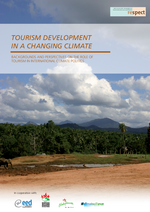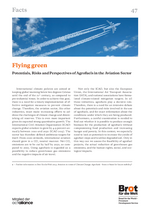Climate justice in tourism?
Eight percent of global emissions of climate-damaging greenhouse gases - i.e. almost every 12th ton – come from tourism1. The lion's share of this is generated when travelling to and from the destination, especially when flying.
Climate killer aircraft
Flying is by far the most climate-damaging means of transport. In addition to carbon dioxide (CO2), other substances that form clouds are released at flight altitude. These factors increase the climate effect by about three times the amount of pure CO2 emissions2. Irrespective of this, air traffic continues to grow unchecked. The current number of flights is expected to double within the next 20 years – almost 8 billion flights will be booked each year3. This will also result in rapidly growing emissions. The European Commission estimates that greenhouse gas emissions from aviation will increase fourfold to eightfold by 20504.
A temperature rise of more than 1.5 degrees can only be prevented if emissions are halved by 2030. By 2050, the total emissions must then be brought to zero. Climate scientists expect catastrophic, uncontrollable consequences for humans and nature if the temperature rises sharply. But the world is far off course. According to the current promises of the states within the framework of the Paris Agreement, the international community of states is heading for a warming of between 2.6 and 4 degrees Celsius. Without a drastic reduction in absolute emissions from aviation, the 1.5-degree target will not be achieved.
Further information: www.de-ipcc.de/256.php
Who's flying? Who's paying?
Flying is largely a privilege of the global middle and upper classes. The Stay Grounded initiative estimates that less than 10% of people have ever boarded an airplane5. The majority comes from the Global North and increasingly from the growing middle classes of emerging economies. However, people in the Global South who have never flown themselves suffer most from the consequences of the climate crisis. Environmental disasters, such as typhoons, destroy houses and fields; prolonged droughts and water shortages endanger the livelihoods of smallholder farmers; rising sea levels become the cause of migration.
The true cost
In Europe, a taxi to the airport often costs more than a plane ticket. But how is that possible? With miserable working conditions, wage dumping and deregulation, airlines are pushing prices down. Many countries support airports, airlines and aircraft manufacturers with subsidies and tax breaks6. In the EU, kerosene is not taxed and VAT is not levied on international flight tickets. According to information from the German Environment Agency, these tax benefits amount to more than 10 billion euros7 in Germany alone. This distorts prices in favour of the climate-damaging aviation industry.
Neither the airlines nor the frequent flyers pay the true cost. Those most affected by climate change are left to fend for themselves with the negative consequences of air traffic, as are those living near airports who have to deal with the noise and particulate matter. In order to be prepared for rising air traffic, more than 550 airports worldwide are currently being built or expanded8. As a result, land is increasingly being used for new terminals and runways. Consequently, entire communities are being forced to relocate, the living space for humans and animals is becoming more and more scarce and landscapes are being cut up.
The fairy tale of green flying
Technical innovations and more efficient aircraft can partially reduce emissions. However, the industry is growing much faster than it is increasing its efficiency, so absolute emissions continue to rise. Even if a technical breakthrough were achieved, it would take decades for these effects to reach the mass market. In addition, the industry is relying on the increased use of biokerosene from renewable agricultural crops instead of fossil fuels alone. Fertile arable land is needed for industrial monocultures. If food ends up in tanks instead of on plates, there is a risk of land grabbing and hunger.
At UN level, the International Civil Aviation Organisation (ICAO) is responsible for regulating emissions from international aviation. However, it is primarily the interests of the aviation industry that determine ICAO policy. This is also reflected in the "Carbon Offsetting and Reduction Scheme for International Aviation" (CORSIA) developed in 2016.
In it, the industry commits itself to cap its CO2 emissions from 2020 and strives for "climate-neutral" growth. In plain language, this means that the growth in emissions from aviation is to be offset from 2020 by climate protection activities in other sectors. Within the framework of CORSIA, an additional market-based offsetting mechanism is being set up. Its effectiveness depends heavily on the environmental and social standards that climate projects must meet. To date, however, it is not clear how ambitious the climate projects will be, which will then be able to sell their certificates to the states or airlines under CORSIA.
Publications

Tourism Development in a changing Climate
Backgrounds and Perspectives on the Role of Tourism in International Climate Politics
Download (PDF)What you can do:
Explore your surroundings
It doesn't always have to be a long distance trip. Mobility causes 75% of emissions from tourism. The shorter the journey, the lower the climate impact of your trip.
Using climate-friendly means of transport
Avoid flying and use climate-friendly alternatives. Short-haul flights in particular have a disproportionate impact on the environment, as take-off and landing consume additional energy. Within Germany, you can get from door to door faster by train than by plane. Many routes within Europe can also be easily explored by train or long-distance bus.
Fly less, stay longer
Climate justice stops at the airport. The basic rule is: fly less often and stay longer at the destination. The local population also benefits from a longer stay because you make more use of services. Avoid feeder flights. Take advantage of Rail and Fly offers and take the train to your international departure airport.
Compensating for air travel
If you are travelling a long distance and cannot do without a plane, then compensate for that. Choose providers who offset their emissions according to the highest standards and take into account not only pure CO2 emissions, but also the climate impact of the flight altitude. A Radiative Forcing Index (RFI factor) of at least 2.7 is appropriate. We recommend, for example, Atmosfair and the church climate collection.
- Lenzen et al (2018):The carbon footprint of global tourism. https://www.nature.com/articles/s41558-018-0141-x
- Amosfair (n.D.): Klimawirkung des Flugverkehrs https://www.atmosfair.de/de/fliegen_und_klima/flugverkehr_und_klima/klimawirkung_flugverkehr/
- IATA (2016): IATA Forecasts Passenger Demand to Double Over 20 Years https://www.iata.org/pressroom/pr/Pages/2016-10-18-02.aspx
- European Commission (n.D.) Reducing emissions from aviation https://ec.europa.eu/clima/policies/transport/aviation_de#tab-0-0
- Stay Grounded (2018): Am Boden bleiben. 13 Schritte für ein gerechtes Transportwesen und eine schnelle Verringerung des Flugverkehrs. https://stay-grounded.org/position-paper/position-paper-de/
- Gössling. Fichert und Forsyth (2017): Subsidies in Aviation. Sustainability 2017, 9(8), 1295; doi:10.3390/su9081295
- Umweltbundesamt (2014): Umweltschädliche Subventionen in Deutschland. http://www.umweltbundesamt.de/publikationen/umweltschaediche-subventionen-in-deutsch- land-2014
- Finance and Trade Watch (2017): Grünes Fliegen – gibt es das? http://www.ftwatch.at/wp-content/uploads/2017/10/FT-Watch_Gruenes-Fliegen_2017.pdf
Additional sources
- BUND e.V. et al (2015): NGO-Luftverkehrskonzept: Schritte zu einem zukunftsfähigen und umweltverträglichen Luftverkehr in Deutschland
- Hall, Scott und Gössling (2013): The Primacy of Climate Change for Sustainable International Tourism. https://www.researchgate.net/publication/264488262_The_Primacy_of_Climate_Change_for_Sustainable_International_Tourism
- Peeters, P. (2017). Tourism’s impact on climate change and its mitigation challenges: How can tourism become ‘climatically sustainable’? https://www.cstt.nl/userdata/documents/peeters-phd2017-thesis.pdf


![[Translate to english:] Blick aus Flugzeug](/fileadmin/tourismwatch/_processed_/9/4/csm_klima_3d39921270.png)
